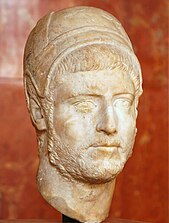User:Aruark/sandbox
| Part of a series on the |
| Priesthoods of ancient Rome |
|---|
 |
| Major colleges |
| Other colleges or sodalities |
| Priests |
| Priestesses |
| Related topics |
The quindecimviri sacris faciundis were part of an Ancient Roman college (collegium) of priests.
The priesthood began with two men of patrician status called the duumviri (or duoviri). The priests were elected from the noble families of Rome.[1] In 367 BCE, their number was increased to ten by the Licinio-Sextian law (thus being renamed decemviri). This law also required for half of the priests to be plebs. During the Middle Republic, members of the college were admitted through co-option. The college increased in size again in 51 BCE to fifteen priests (quindecim). The collegium eventually had sixteen members, however, their title remained the same.[2]
The quindecimviri were primarily responsible for guarding the Sibylline Books, books of prophecy regarding the fate of Rome that were obtained from the Delphic Oracle. They consulted and interpreted these at the request of the Senate. This collegium also oversaw the official adoption of any foreign gods introduced to Rome. A notable example being the introduction of Magna Mater during the Second Punic War. During the Empire, along with their other duties, they acted as authorities of the Secular Games.[3] Other responsibilities included acting as officers of censorship and judicial magistrates outside of Rome.
References[edit]
- Beard, M., North, J., & Price, S. R. F. (1998). Religions of Rome . Cambridge; New York: Cambridge University Press.
Bibliography[edit]
Andrew Lintott, The Constitution of the Roman Republic (Oxford University Press, 1999), pp. 183–184 online.
Beard, M., North, J., & Price, S. R. F. (1998). Religions of Rome . Cambridge; New York: Cambridge University Press.
Category:Ancient Roman religious titles Category:Pagan religious organizations
- ^ Beard, M., North, J., & Price, S. R. F. (1998). Religions of Rome . Cambridge; New York: Cambridge University Press.
- ^ Beard, M., North, J., & Price, S. R. F. (1998). Religions of Rome . Cambridge; New York: Cambridge University Press.
- ^ Beard, M., North, J., & Price, S. R. F. (1998). Religions of Rome . Cambridge; New York: Cambridge University Press.
